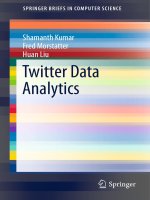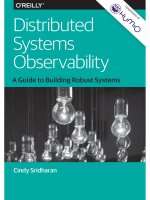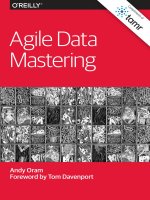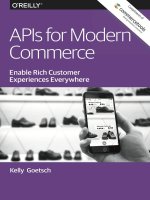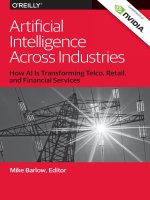IT training OReilly augmented analytics ebook khotailieu
Bạn đang xem bản rút gọn của tài liệu. Xem và tải ngay bản đầy đủ của tài liệu tại đây (4.09 MB, 37 trang )
Co
m
pl
im
en
ts
of
What Is
Augmented
Analytics?
Powering Your Data with AI
Alice LaPlante
REPORT
Augmented
Analy�cs
Empower Business
with AI and
Data-Driven
Insights
Learn More
oracle.com/analy�cs
What Is Augmented
Analytics?
Powering Your Data with AI
Alice LaPlante
Beijing
Boston Farnham Sebastopol
Tokyo
What Is Augmented Analytics?
by Alice LaPlante
Copyright © 2019 O’Reilly Media, Inc. All rights reserved.
Printed in the United States of America.
Published by O’Reilly Media, Inc., 1005 Gravenstein Highway North, Sebastopol, CA
95472.
O’Reilly books may be purchased for educational, business, or sales promotional use.
Online editions are also available for most titles (). For more infor‐
mation, contact our corporate/institutional sales department: 800-998-9938 or cor‐
Acquisitions Editor: Jonathan Hassell
Development Editor: Melissa Potter
Production Editor: Deborah Baker
Copyeditor: Octal Publishing, LLC
July 2019:
Proofreader: Charles Roumeliotis
Interior Designer: David Futato
Cover Designer: Karen Montgomery
Illustrator: Rebecca Demarest
First Edition
Revision History for the First Edition
2019-07-02: First Release
The O’Reilly logo is a registered trademark of O’Reilly Media, Inc. What Is Augmen‐
ted Analytics?, the cover image, and related trade dress are trademarks of O’Reilly
Media, Inc.
The views expressed in this work are those of the author, and do not represent the
publisher’s views. While the publisher and the author have used good faith efforts to
ensure that the information and instructions contained in this work are accurate, the
publisher and the author disclaim all responsibility for errors or omissions, includ‐
ing without limitation responsibility for damages resulting from the use of or reli‐
ance on this work. Use of the information and instructions contained in this work is
at your own risk. If any code samples or other technology this work contains or
describes is subject to open source licenses or the intellectual property rights of oth‐
ers, it is your responsibility to ensure that your use thereof complies with such licen‐
ses and/or rights.
This work is part of a collaboration between O’Reilly and Oracle. See our statement
of editorial independence.
978-1-492-05842-7
[LSI]
Table of Contents
What Is Augmented Analytics?. . . . . . . . . . . . . . . . . . . . . . . . . . . . . . . . . . . 1
Executive Summary
A Growing Market
Augmented Analytics: A Primer
Benefits and Roadblocks of Augmented Analytics
Who Is Using Augmented Analytics?
Best Practices for Augmented Analytics
Real-World Uses of Augmented Analytics
Riverbed
Conclusion
1
3
3
11
13
14
17
22
29
iii
What Is Augmented Analytics?
Executive Summary
Businesses are collecting ever-larger volumes of data—structured
and unstructured alike. IDC predicts that the “global datasphere”
will grow from 33 zettabytes (ZB) in 2018 to 175 ZB by 2025. This
number is staggering. Note that one zettabyte is approximately equal
to one billion terabytes. If each terabyte were a kilometer, a zettabyte
would be equivalent to 1,300 round trips to the moon. Now multiply
that by 175 and you begin to get the picture of the data deluge
today’s businesses face.
Businesses that figure out how to make decisions using all this data
—those that are “data driven”—will come out ahead. By making bet‐
ter use of their rich information resources to make better decisions,
they will perform better than those that operate on gut feel or anec‐
dotal evidence. Forrester found that data-driven companies grow
eight times faster than those that work from intuition. Indeed, such
“insights-driven” businesses grow, on average, an impressive 30%
annually and are forecast to earn $1.8 trillion more than their lessadvanced peers by 2021, as illustrated in Figure 1-1.
But traditional analytics solutions will take businesses only so far
when attempting to make use of data.
1
Figure 1-1. Insights-driven businesses have a distinct advantage
Augmented analytics is the latest way to think about data and ana‐
lytics. It includes embedding artificial intelligence (AI), often in the
form of machine learning and natural language processing (NLP),
into traditional analytics. It is vastly different from traditional ana‐
lytics or business intelligence (BI) tools because these AI technolo‐
gies are always working in the background to continuously learn
and enhance results. In particular, augmented analytics allows faster
access to insights derived from massive amounts of structured and
unstructured data; this intelligence helps uncover hidden insights,
remove human bias, and predict bias.
By deploying augmented analytics, not only can organizations
democratize use of the data—that is, make it easy for business users
and executives to make decisions based on data without help from
data scientists or IT professionals—but they can go beyond predic‐
tions of future business events or scenarios and access unbiased pre‐
scriptive advice on what to do next.
In this report, we precisely define what augmented analytics is. We
explain how analytics that are driven by machine learning and AI
accelerates time to insights from all of your data, and brings intelli‐
gence to help uncover hidden insights, remove human bias, predict
results, and even prescribe solutions. We explain best practices for
deploying augmented analytics, and show how you can use augmen‐
ted analytics practically within real-world case studies.
2
|
What Is Augmented Analytics?
A Growing Market
Augmented analytics is a high-growth force in business today. Ana‐
lyst firm Research and Markets predicts that the global augmented
analytics market will grow from $4.8 billion in 2018 to $18.4 billion
by 2023, at a compound annual growth rate (CAGR) of a very
impressive 30.6% at a time when the enterprise software market is
expected to grow at only an 8% CAGR. Growth of augmented ana‐
lytics will be highest in the banking, financial services, and insur‐
ance markets.
According to a recent survey, embedding machine learning in ana‐
lytics is a top 10 concern of BI and analytics stakeholders, including
users, vendors, and analysts, as shown in Figure 1-2.
Figure 1-2. Importance of augmented analytics
The McKinsey Global Institute performed an analysis of the value
created by embedding machine learning in analytics across 400
enterprise use cases and found that the technologies have the poten‐
tial to create as much as an additional $15.4 trillion in value by 2020.
But what exactly is augmented analytics? Let’s examine that before
we move on.
Augmented Analytics: A Primer
Augmented analytics is the marrying of two technologies: analytics
and AI. We discuss these separately, and then explain what happens
when you bring them together in a single solution or platform that
possesses contextual awareness.
A Growing Market
|
3
Analytics
Analytics is the process of identifying patterns in data. It uses statis‐
tics, operations research, and other mathematical tools to make
sense of information generated or collected by organizations. It is
especially helpful as data volumes grow, when manual calculations
are too difficult or complex.
In this era of big data, analytics has become essential to doing every‐
thing from understanding sales trends to segmenting customers
based on their online behaviors to predicting how much inventory
to hold. Yes, the data itself is a tremendous asset, but analytics is
what makes data deliver value. And not just to business, but to
sports, medicine, engineering, or any activity in which large
amounts of data are involved.
AI
AI is the computer science practice of building automated systems
that are able to perform tasks that normally require human intelli‐
gence. AI encompasses a broad range of technologies, such as com‐
puter vision, NLP, and neural networks.
Machine learning is one of the technologies that falls under the
umbrella of AI. It makes it possible for systems to learn from pro‐
cessing data. In other words, computer systems don’t need to be
specifically programmed by humans to anticipate every scenario—
they automatically learn and improve from what the data tells them,
and from their experience with that data, to make better predictions
or decisions.
IDC predicts that enterprise spending on AI solutions will top $77.6
billion in 2022, more than three times the $24.0 billion in 2018, as
illustrated in Figure 1-3. This represents an “impressive” 37.3%
CAGR between 2017 and 2022, according to IDC.
The top reason that marketers are adopting machine learning and
analytics is to improve the customer experience. A full 82% of enter‐
prises already use machine learning to personally target customers,
and 64% use it to deliver targeted content and promotions to them.
4
| What Is Augmented Analytics?
Figure 1-3. Spending on AI solutions is accelerating.
All of this is paying off. McKinsey discovered that 82% of businesses
that adopted machine learning received, on average, a 17% return
on investment (ROI). Companies in the technology, media and
entertainment, and telecommunications fields are achieving the
highest ROI.
Data scientists write the mathematical models underlying machine
learning systems. Machine learning modeling requires significant
skill, education, and training, and the data professionals capable of
doing this are scarce. According to LinkedIn, demand for data sci‐
entists is “off the charts,” with a shortage of more than 150,000 data
scientists in the US alone. Happily, many AI and machine learning
models in the public domain can be found on community websites
for free; businesses can use these models to get started with AI and
machine learning.
Bringing It All Together
When you embed machine learning and AI into analytics, you get
augmented analytics. Augmented analytics is a technology that auto‐
mates the selection and preparation of data, the generation of
insights, and the communication of those insights. The main thing
that is new in this space is the democratization of advanced analytics
tools. Today, advanced analytics is available to a broad range of busi‐
ness users: executives, managers, line-of-business workers, and citi‐
zen data scientists—those employees who have a natural aptitude
and excitement for data science without the formal training.
Augmented analytics solutions come prebuilt with models and algo‐
rithms so that companies don’t need a data scientist to do this work.
And these models are hidden under much friendlier interfaces so
that users without data science training or PhDs in statistics can use
Augmented Analytics: A Primer
|
5
the tools. Indeed, this is one of the key differences between augmen‐
ted analytics and traditional analytics. With augmented analytics,
the AI and machine learning are built into the product. The very
complex model-building and number-crunching is still happening
—but it’s always on, always working in the background to continu‐
ously learn and help users make more accurate decisions.
Because leading augmented analytics platforms feature NLP, this
allows nontechnical users to easily ask questions from source data;
natural language generation (NLG) then automates the process of
translating complex data into text with intelligent recommendations,
thereby accelerating analytic insights.
By using automated recommendations for data enrichment and vis‐
ualization, anyone can quickly uncover unseen patterns and predict
trends to optimize the time it takes to go from data to insights to
decisions.
The Business Application Research Center (BARC) 2018 Business
Intelligence Survey found that augmented analytics will completely
transform the user experience, making the shortage of data scientists
less urgent for many businesses.
NLP technology also helps drive the ability for nonexpert users to
make sense of large amounts of data. Users can ask questions of the
data using standard business terminology, and the software will find
and query the right data and make the results easy to digest using
visualization tools or natural language output.
Augmented analytics can help every data-hungry user of analytics—
from business analysts to IT professionals, to the C-suite—in the
following ways:
Recommend, prepare, and enrich data
Rather than having to decide which datasets to query, as with
traditional analytics, an augmented analytics solution will rec‐
ommend which datasets to include in analyses, alert users when
those datasets are updated, and suggest new datasets if users are
not getting the results they expect.
Create instant charts and graphics
This helps interpret and communicate results in an easily
understandable context to help make swift business decisions.
6
|
What Is Augmented Analytics?
Natural language interfaces
This allows users to do querying in natural language, to activate
speech-to-text capabilities, and to get results generated—and
even spoken—using everyday business language.
Forecast trending and clustering of data
It takes just one click to get accurate forecasts and predictions
based on historical data.
Use proactive, personalized analytics with mobile applications
Augmented analytics provides a personalized assistant that
understands individual users—such as using their location to
determine what charts to present to a client at an offsite sales
meeting.
Augmented analytics will also be personalized and proactive to the
extent that it will present insights based on patterns it detects in
users’ questions. Through self-learning, it will even anticipate future
questions that perhaps a user hasn’t yet thought of.
Oracle’s Data Analytics Maturity Model
Oracle has defined the analytics maturity model as consisting of
three waves: centralized, self-service, and augmented, as illustrated
in Figure 1-4.
Figure 1-4. The Oracle analytics model (source: Oracle, May 2019)
If you centralize your analytics efforts, you get centralized data and
semantic information for consistent metric definitions. This results
Augmented Analytics: A Primer
|
7
in stronger governance than if your data is scattered throughout
multiple repositories or datacenters.
If you build a self-service model for analytics so that users don’t
need to involve a data “gatekeeper” to get access to the data they
need, you will boost user productivity dramatically, speeding up
business decisions. You will also be able to use nonstandard datasets
from external or personal sources, such as suppliers, customers, and
external data feeds such as commodity prices or weather data.
Finally, if you apply automation, machine learning, and AI within
your analytics process, you will realize faster time to insights from
your data, which means faster time to decisions and the ability to
become a true data-driven business.
It’s important to understand that this is not a linear model. You do
not need to centralize your augmented analytics initiative before you
implement self-service, or achieve self-service before going augmen‐
ted.
Leading modern analytics platforms will offer all three of these
options at one time.
There are four ways to use analytics:
Descriptive
This type of analytics simply looks backward at historical infor‐
mation and describes what happened. You can query the data to
discover, for example, the retail sales volume last quarter or how
high employee turnover was last year. Much descriptive analyt‐
ics work is done by humans using Excel spreadsheets.
Diagnostic
Now that you know what happened, you want to know why. You
use analytics to find out that the reason overall revenues
declined was that sales of women’s shoes dropped precipitously,
or that the reason for heightened employee churn was that a
new manager was hired in the finance department. In this stage,
much of the work is still human centered and not yet automa‐
ted.
Predictive
Analytics can also be applied to data to make predictions about
what will happen next. Based on historical trends—and, impor‐
tantly, assumptions about the future—what will overall revenues
8
| What Is Augmented Analytics?
look like next quarter? The machine does more, and the human
less, of the work in this stage.
Prescriptive
Finally, some recommendations. What should we do to ensure
that sales continue on an upward trajectory?
Eliminating Bias from the Equation
The human-versus-machine control aspect of analytics maturity is
important. Earlier in the analytics maturity model, analytics tools
are controlled by humans—and tend to have human biases. For
example, users who seek answers from data will make assumptions.
They will choose what data to query, and they will structure queries
based on their understanding and preconceived notions about the
topic. Because of this, traditional analytics arguably introduces bias
into the results.
This is where augmented analytics can shine. The data determines
everything—not users’ assumptions. For example, traditionally if
you want to forecast sales for the next quarter, you would make vari‐
ous assumptions, project it out, and build a model based on your socalled expert judgment. You might estimate what the sales growth
rate would be based on economic indicators from Wall Street, for
instance. Alternatively, economists could be predicting a downturn,
and you might project less ambitious sales numbers.
On the other hand, with augmented analytics, the data itself deter‐
mines all of these things. The machine learning model parses data to
identify which datasets to access in response to a query about future
revenues. The model also rephrases the natural language query from
the human into machine language that is impartial. The predictions
then typically are more accurate and, in many cases, much faster.
Also, augmented analytics can actually inform users about other
datasets that might be useful in completing a particular analysis.
Augmented Analytics in the Cloud
Although businesses can certainly deploy augmented analytics on an
on-premises infrastructure, many, if not most, organizations choose
a cloud-based infrastructure. The prime reasons are elastic scalabil‐
ity and cost effectiveness. AI technologies such as machine learning
and NLP are very compute-intensive—they require lots of CPUs, or
Augmented Analytics: A Primer
|
9
even very costly graphics processing units (GPUs)—but they are not
necessarily predictable in when they demand those resources. Many
businesses will thus experience tremendous peaks and troughs in
processing, and the differences between the highs and lows can be
massive. Businesses that stick with an on-premises infrastructure
must plan for those peaks by provisioning sufficient compute, stor‐
age, and network resources, and plan for future growth by purchas‐
ing all of the resources upfront. This incurs high capital as well as
operational costs because of course after those resources have been
provisioned and deployed, they must also be managed and main‐
tained. This is not only costly, it is slow given that provisioning new
servers can take months in some organizations. And then many of
those resources might be left unused much of the time.
Also, because the cloud can handle much larger amounts of data,
you never need to aggregate or truncate data so that it fits on your
on-premises infrastructure. Optimizing machine learning requires
that all data be used to produce the most accurate predictions. Data
should also be used in its lowest granularity to prevent the introduc‐
tion of false insights based on preaggregations. Indeed, aggregating
or truncating data can defeat the very business agility that analytics
is supposed to achieve.
It’s not surprising then, that according to a recent Deloitte study,
only 15% of companies say they prefer on-premises platforms when
deploying AI. (Keep in mind that this 15% of companies includes
firms in industries, like finance and gaming, which are required by
law to remain on-premises.) The popularity of cloud-based AI plat‐
forms is further confirmed by their annual global growth rate, which
Deloitte estimates to be a “remarkable” 48.2%.
In the cloud, businesses can dynamically provision whatever resour‐
ces they need and scale up and down as required. This pay-only-forwhat-you-need model is not only cost-effective, but it also makes
businesses extremely agile in that new compute and storage can be
provisioned in minutes, not weeks or months.
Indeed, the cloud is essential for delivering many of the benefits of
augmented analytics, as we explain in the next section.
10
| What Is Augmented Analytics?
Benefits and Roadblocks of Augmented
Analytics
Many benefits accrue to businesses that move up the maturity curve
from traditional analytics to augmented analytics. But there are a
couple of potential roadblocks you should be aware of. We cover
both in this section.
Benefits of Augmented Analytics
Here are four of the chief benefits that businesses are deriving from
augmented analytics.
Make faster decisions
Business agility is on everyone’s mind these days. The ability to react
swiftly and decisively in response to changes in volatile markets is
essential. Today, with new competitors arising from unlikely places,
businesses can’t wait weeks or even days to get the information
required for both strategic and tactical decision making. With aug‐
mented analytics, getting complete, easy-to-decipher reports in
response to even highly sophisticated ad hoc queries into the hands
of those who need them can be achieved much more rapidly than
with traditional analytics solutions.
Make better decisions
It’s not just speed that matters. In the past, executives would make
snap decisions based on limited information and gut feel only—
often with disastrous results. With augmented analytics, your deci‐
sions can be based on facts and hard numbers. Additionally, because
of AI and machine learning, all available data—structured and
unstructured—can be processed. Using all available data versus just
subsets of data ensures that you get better insights from the resulting
analyses, and thus make better, more confident, and more trustwor‐
thy decisions.
Democratize data use throughout your organization
There has been talk for decades about the democratization of data—
making data available to every employee who needs it—and of
empowering citizen data scientists. Augmented analytics finally
makes this possible. AI in the form of complex machine learning
Benefits and Roadblocks of Augmented Analytics
|
11
algorithms and NLP is all there, under the covers, putting insight at
the fingertips of anyone who needs it. In the future, AI will be every‐
where analytics is, and will become second nature to everyone.
Leading augmented analytics solutions come with out-of-the-box
embedded machine learning and AI models in them, so users can
get started immediately on analyses with very little training.
Although data scientists are still required to adjust these models or
to build additional ones, the productivity of regular business users
and nondata specialist users soars immediately upon deploying
these solutions.
Become a true data-driven company
Most organizations today strive to be data driven—or to follow what
the data tells them. The documented financial payoff is certainly
worth it. By deploying augmented analytics, users of all types
throughout your organization get the deep insights they need from
the data to make better decisions without requiring hand-holding
from data professionals or IT.
Roadblocks to Using Augmented Analytics
To take advantage of the many benefits we just outlined, businesses
must overcome some obstacles to take advantage of augmented ana‐
lytics throughout their operations. These barriers fall into two cate‐
gories: technical and cultural.
Technical impediments
The biggest issue, particularly for larger or more established compa‐
nies, is the so-called technical debt—the existing large investment in
legacy technologies that they can’t simply abandon in rip-andreplace scenarios. This includes legacy infrastructure, too. How do
you cost-effectively move to the cloud for augmented analytics when
you’ve already put substantial investment into traditional onpremises databases and analytics tools? This is not something that
can be done overnight.
That’s why newer companies, or companies “born in the cloud,” will
have a much easier time moving swiftly into the augmented analyt‐
ics world.
12
|
What Is Augmented Analytics?
Cultural impediments
In addition to technical roadblocks, there are the cultural and
organizational issues to consider. It’s not easy to move from a tradi‐
tional analytics model, in which IT acts as gatekeeper to the precious
company datasets, to a self-service model in which anyone can
query the data to get an answer to pressing business questions.
Although attitudes have improved as data becomes more generally
available, there’s still the ingrained belief that knowledge is power.
People might want to hold onto the advantage they feel they get by
knowing things others don’t. Training is probably necessary to help
employees overcome this barrier.
Perhaps most important, decisions should no longer be made by the
HIPPO (the highest-paid person in the office) but by listening to
what the data tells you. This can be an immense cultural shift—ask‐
ing people to come to meetings armed with data, not opinions.
Although a fairly recent technological development, augmented
analytics is already being used by Fortune 1000 companies through‐
out various industries—including manufacturing, finance, life scien‐
ces, ecommerce, energy, internet, and health care. We discuss who
uses augmented analytics in the next section.
Who Is Using Augmented Analytics?
Augmented analytics is being used today to get accurate, unbiased,
and actionable insights across a broad range of business functions.
Here are some of the ways it is being used:
Sales
Salespeople don’t need to know what datasets might have the
information they are looking for, and they don’t need to learn
difficult statistical terms or interfaces. They can say “show me
sales for this region,” and the NLP technology interprets that
speech into language the system can understand. The machine
learning finds the relevant data and even determines the best
charts to show to visualize the data in context. Salespeople can
use this in the field on their mobile devices, and intelligent loca‐
tor technology such as GPS will let the system know what geo‐
graphical data is relevant. A sales professional might want to do
a more complex analysis, and ask “Why are sales down in our
eastern territory?” The machine learning system will perform a
Who Is Using Augmented Analytics?
|
13
root cause analysis and display the answer in easily understand‐
able words and graphics.
Marketing
Marketing professionals today want quantitative results for how
well their campaigns are doing on a very granular level—and
then they want to drill down to see why a particular campaign
might be doing better in one region or among one customer
segment than another. Augmented analytics can do this and also
inform marketers about the existence of additional data about
target audiences that they weren’t aware of that will make cam‐
paign targeting much more effective.
Finance
With traditional analytics, financial predictions involve making
a significant number of assumptions: estimated economic
growth, expected interest rates, or other external forces over
which finance professionals might have opinions but not facts.
With augmented analytics, the machine learning bases its pre‐
dictions on the data only, leaving individual judgment and bia‐
ses out of it, so organizations get more accurate predictions
about revenues and profitability.
Human Resources (HR)
With traditional analytics, it’s common for HR professionals to
ask questions like “Why is attrition up?” only to get historical
charts of the last three or six months of employee turnover.
They need to dig in further—typically involving IT or data spe‐
cialists—to try to understand why. Augmented analytics makes
the answer to this question actionable. For example, an analysis
of the data could show that turnover is highest around the time
of employee annual reviews, signaling something is wrong with
that process, upon which HR can take immediate action.
To get results like this, companies need to follow some best practices
that pioneers and experts in augmented analytics have identified.
Best Practices for Augmented Analytics
Although the rewards are considerable, moving up the data analyt‐
ics maturity curve takes time—and care. Here are some best practi‐
ces for successfully deploying augmented analytics.
14
|
What Is Augmented Analytics?
Mandate Data-Driven Decision Making from the Top
Down
Senior management must get behind it. No longer can business
departments or groups make decisions based on what the HIPPO
demands. No one should come to a meeting unless prepared to
present data that supports their position. Incentives should be struc‐
tured to reward those who make data-driven decisions.
Empower and Trust Users Throughout Functional Areas
and Organizational Levels
Moving to augmented analytics requires moving to a self-service
data model, which in turn requires trust. This requires building an
“enlightened” organizational culture in which leaders—business and
technical—release control to users so that they can access and use
data to make decisions as appropriate to their roles and responsibili‐
ties.
Balance Self-Service with Centralized Governance
Most organizations with low analytics maturity do not have formal
data governance programs in place. They might have thought about
it, and they might understand the importance of it, but they simply
don’t know where to start. Small companies, especially, struggle
because of the cost barrier of entering into the realm of data central‐
ization and imposing proper governance on analytics initiatives.
Data governance is simply the rules by which data is managed. This
includes acquiring, storing, moving, transforming, analyzing,
reporting, and deleting it. It is the framework by which data is
ensured to follow both internal and external guidelines for security
and privacy. This means that organizations must understand how
data is collected, how it is used, how it moves through the organiza‐
tion, how it’s changed, and how it’s stored. They also need to ensure
that access to data is given on the principle of permissions: there’s no
reason why a finance professional should have access to HR data,
and vice versa. So, you build user profiles to ensure that people have
access to only the data they need to do their jobs. In short, selfservice needs to be carefully balanced with a robust governance
framework that ensures secure data access.
Best Practices for Augmented Analytics
|
15
Ensure a “Single Source of Truth”
In companies that are still stuck in Excel-based analyses, it’s com‐
mon for different users to download different versions of data onto
their desktops or laptops, do independent transformations on that
data, and end up with results that vary widely from one another. A
best practice for organizations is to know where their true data
resides, who owns it, and who manages it so that everyone in the
organization is working off the same version of it, and it isn’t inad‐
vertently changed or corrupted. If your organization currently lacks
a single source of truth, you might have a problem trusting the
results of analyses. Conversely, if everyone is working from the same
dataset, the resulting predictions and insights will be more credible.
Also critical is to ensure consistency of metrics and calculations. You
do this through the semantic layer of your information model—a
common business language that is used to describe data so that
users throughout the enterprise have the same definitions of such
things as product, customer, revenue, and more.
Visualize Big, But Think Small
It’s additionally important to have a long-term strategy that clearly
lays out the business value you expect to get from augmented analyt‐
ics. Then, think small within that vision: after you have your overall
strategy in place, you should adopt augmented analytics on a caseby-case basis based on business needs and where you foresee getting
the maximum payoff. Identify those cases that are directly tied to
immediate business objectives and that promise a high ROI. Avoid
leaping head first into a massive five-year, rip-and-replace project.
Instead, show the value you can get from augmented analytics early
and often, always staying within the parameters of your long-term
vision. Leading augmented analytics platforms allow you to look for
quick wins and to use the hybrid cloud—part on-premises, part
cloud—as your environment. That way, you can get something up
and running quickly, with minimal disruption and training required
for your staff, while retaining overall flexibility.
Consider Moving to the Cloud
If they haven’t already done so, businesses interested in augmented
analytics should consider the cloud. The cloud gives you the flexibil‐
ity to move your workloads to where they run best and more eco‐
16
|
What Is Augmented Analytics?
nomically; the elasticity to scale up and down as your business
demands; robust security; the agility to move on new opportunities
immediately; and the cost effectiveness of paying only for the
resources (compute and storage) that you need. All of these will
contribute to the success of any augmented analytics initiative.
Empower Everyone with Access
With the current dearth of sufficient data scientists, it’s essential to
put people and processes in place so that employees, customers,
partners, and suppliers will use augmented analytics to make busi‐
ness decisions. Anticipate upcoming requirements based on your
overall vision and strategy, and allow yourself sufficient time to
secure the resources you need. Keep IT, data, and business teams
aligned so that each is aware of the other’s needs—and challenges.
Real-World Uses of Augmented Analytics
In this section of the report, we examine how two leading compa‐
nies—one an established consulting firm, and the other a fastgrowing technology firm—are using augmented analytics to gain a
deeper understanding of their internal operations and how to opti‐
mize them while also enhancing their commercial products to better
meet the needs of customers.
Accenture
Accenture is a leading global professional services company, provid‐
ing a broad range of services and solutions in strategy, consulting,
digital, technology, and operations. Combining deep experience and
specialized skills across more than 40 industries and all business
functions, Accenture works at the intersection of business and tech‐
nology to help clients improve performance and create sustainable
value for stakeholders.
Making Augmented Analytics Accessible to All
Through the Accenture myConcerto platform—and, within that
platform, the Accenture Digital Boardroom—Accenture is harness‐
ing augmented analytics using the Oracle Analytics Cloud to help its
clients transform virtually every aspect of their businesses: finance,
supply chain, procurement, human capital management, and others.
Real-World Uses of Augmented Analytics
|
17
In effect, myConcerto is an end-to-end integrated digital platform
consisting of thought leadership, approaches, methodologies, assets,
and accelerators that Accenture customers can apply to their most
complex business scenarios. An insight-driven, integrated platform,
myConcerto helps organizations boost their ability to innovate,
amplify business results, and accelerate their journeys to becoming
intelligent enterprises.
“Think of myConcerto as our one-stop shop for everything you
need in Oracle Cloud,” says Patrick Sullivan, head of Accenture’s
Oracle Business Group in North America. “Everything we do, from
SaaS [software as a service], to PaaS [platform as a service], to IaaS
[infrastructure as a service], and to all the different subclouds, are
in it.”
So, whether a client is seeking augmented analytics, enterprise
resource planning (ERP), or human capital management (HCM)
solutions, they’ll find all of Accenture’s intellectual property, innova‐
tion accelerators, assets, and solutions within myConcerto, says Sul‐
livan—and it’s purpose-built for Oracle Cloud.
The Digital Boardroom is one of the offerings within myConcerto.
“With the Digital Boardroom, we’ve embedded our proprietary pre‐
dictive analytics, proven models, and applied intelligence assets
along with best practices into Oracle Analytics Cloud to create a sin‐
gle intelligence platform,” says Brad Genson, head of Accenture’s
Oracle Analytics Group for North America. “We’re showing execu‐
tives that they can not only see how their businesses are doing now,
but they can also predict, and look into the future, as well.”
Accenture believes that the Digital Boardroom is unique in the mar‐
ket because of the Accenture thought leadership that it uses to aug‐
ment Oracle Analytics Cloud. “We harvest our thought leadership
on what metrics are critical in managing finance, in managing
HCM, and in managing the supply chain. We add in our predictive
analytics assets and experience to complement what Oracle Analyt‐
ics already delivers,” says Genson.
Real-World Deployments of the Digital Boardroom
Already in use around the globe, the Digital Boardroom has been
proven successful across a number of corporate functions. Here are
two use cases: ERP and HCM.
18
|
What Is Augmented Analytics?
Use case #1: ERP
One of Accenture’s clients had just completed a finance and HCM
software-to-service deployment. The initiative was very successful,
achieving all of its desired results. But some of the executive spon‐
sors wanted more. They hoped to derive additional value from the
investment and thought it could be done by using analytics on all of
the data that was flowing in.
One of the key challenges was that valuable data still existed in silos.
Users seeking metrics on liquidity needed to delve into one set of
Excel files. Users wanting to track spend against budget by depart‐
ment would need to go to another set. It was inefficient and wasted
the time of valuable knowledge workers.
Accenture worked with the client to rapidly pull all of the data into
the Oracle Cloud and deploy Oracle Analytics Cloud. “We harvested
some of our initial thought leadership and decided what we thought
was important from a financial point of view,” says Genson. Accen‐
ture then “baked” that into Oracle Analytics and was able to rapidly
deploy a CFO dashboard in just four weeks. “We improved visibility
into the firm’s liquidity as well as other core financial metrics and
really improved the value for the CFO and the benefits they were
getting from the overall initiative,” Genson says.
With visibility to the problem and opportunity areas, the organiza‐
tion is seeking to achieve the following sampling of benefits to
improve overall liquidity and cash flow position:
• 85% to 95% accuracy in forecasting capital availability
• 5% to 7% reduction in late payments
• 5% to 10% recovery and reduction of excess payments
• 20% to 30% increase in cash collection
• 10% to 20% working capital benefit by optimizing payments
• 80% to 90% identification of travel and expense violations
• 1% to 3% reduction of travel and expense costs
Among other things, the augmented Oracle Analytics solution gave
executives very fast and granular access to corporate spend data, so
they could see what departments were over budget while accessing a
clear view of how well they were doing on contract compliance.
Real-World Uses of Augmented Analytics
|
19
